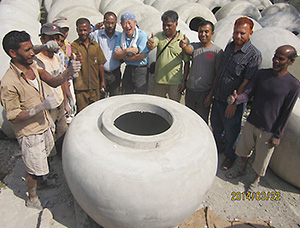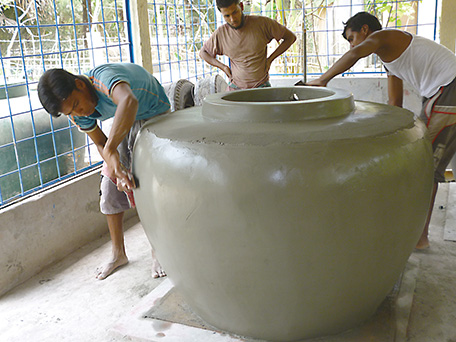Master Techniques, From Japan to the World - 2
A social business provides safe water for all through the sale of rainwater tanks
– Promoting the use of rain water tanks across Bangladesh, a country with worsening water problems

In front of the 1,000th AMAMIZU rainwater tank produced. Dr. Murase is in the center. (Photo: Makoto Murase)
In recent years, water issues have become more and more serious among developing countries in Asia. Many in the region struggle with various issues related to water, which is the source of life, such as an inability to secure necessary quantity or lack of access to safe water. Dr. Makoto Murase is a man known internationally as “Dr. Skywater” for his work in promoting rainwater use over many years as a public officer working for Sumida City Office in Tokyo and the Director of the Non-Profit Organization (NPO) People for Rainwater. He had the idea that rainwater might be used to help people around the world troubled by water issues.
During his time at Sumida City Office, Dr. Murase addressed the challenge of reducing damage caused by flooding in urban areas by collecting rainwater and making effective use of it. In 1985, during the construction of the Ryogoku Kokugikan (a sumo arena), he worked hard to install a rainwater tank that collects rainwater so it can be used. He explained, “If rainwater flows into the sewer, it becomes flood water. If you collect it, it becomes a resource.”
Utilizing his experiences in Japan, Dr. Murase turned his attention next to helping Bangladesh address its water issues. Many people in Bangladesh use pond water as drinking water on a daily basis, but this poses a number of sanitation problems, as the water is polluted with salts and organic compounds that frequently cause diarrhea in those who drink it. Many wells have been dug in response to this problem. However, many of those wells have in turn been found to be polluted with arsenic. In fact, the geological stratum beneath Bangladesh contains arsenic, polluting 30% of the wells in the country. Dr. Murase went looking for places with dire water problems, and this led him to Bagerhat District in the southwestern part of the country. He started working to improve the water situation there in 2000. In 2010, he established the Institute for Skywater Harvesting Ltd., Japan, and cooperated with a consulting company to apply for JICA's Preparatory Survey for BOP Business Promotion in FY2010. That project was approved, and so a survey was conducted on the possibility of starting a rainwater tank business in Bangladesh.
“People in this area have a history of collecting rainwater for drinking in an earthenware vessel called a ‘motka' since ancient times. However, the motka can only hold around 100 liters of water at most, and can break easily. That was why I thought of creating and selling a rainwater tank that could hold more water and would not be as easy to break.”
From his past experience, Dr. Murase knew that low cost and sturdy mortar vessels were widely used in the northeastern part of Thailand, where people frequently collect and use rainwater for various purposes. Dr. Murase believed that the method the Thai employed to make these vessels could also be used in Bangladesh. He dispatched a Bangladeshi plaster worker to Thailand to learn that method.
“I suppose it took about one year until the craftsperson was able to completely learn the necessary techniques. The mud, cement, and sand used in Thailand is of a different quality from that used in Bangladesh, so in the beginning it was a continual process of trial and error. Nevertheless, I always made sure to use local people and materials. That allowed us to reduce production costs, and it also led to the creation of local employment opportunities.”

Tanks are made by local people, using locally produced materials based on the concept of “local production for local consumption.”(Photo: Makoto Murase)
The mortar rainwater tanks this project has produced can hold 1,000 liters, and have been named “AMAMIZU.” Within that name is the feeling of reverence for nature, a feeling of gratitude to the heavens (“AMA”) for the blessing of water (“MIZU”). Sales of AMAMIZU got off to a good start in 2012 with 200 vessels sold. In 2013, Dr. Murase set up Skywater Bangladesh Ltd., and continued on to produce steady results, including the sale of another 600 AMAMIZU vessels. Since JICA's Preparatory Survey for BOP Business Promotion indicated that 50 percent of villagers would be able to purchase a tank if it was priced at 3,000 taka (1,000 taka is equivalent to approximately $12.8 as of Dec. 2014), the starting price for the AMAMIZU vessels was set at 3,000 taka. The company later decided to offer a package price of 4,300 taka (approximately $55.2) that includes an AMAMIZU tank and covers the costs of transport and installation of drain spouts. The company has also set up a system by which customers can pay in installments in order to allow as many people as possible to purchase a tank.
Dr. Murase pointed out the importance of continuing with international cooperation as a social business: “I do not mean to put down the use of grant aid, but I think that, to keep international cooperation projects moving forward, it is vital to make them sustainable by introducing ideas of cost management while fostering ownership. We must aim to make our projects develop into sustainable businesses that play a vital part in local economies. Without this mindset, I think our projects would all end merely as short-lived isolated initiatives.
“Japan is an advanced country in Asia in terms of the use of rainwater. We are blessed with rain because of the clouds blown over by monsoon winds from the direction of Bangladesh. The skies above Japan and Bangladesh are connected. Their water problems do concern us too. I think it is important for Japan to make an active international contribution in this field.”
<< Previous Page Next Page >>
Main Text | Statictics and Reference Materials | Stories from the field | Master Techniques, From Japan to the World - | ODA Topics
